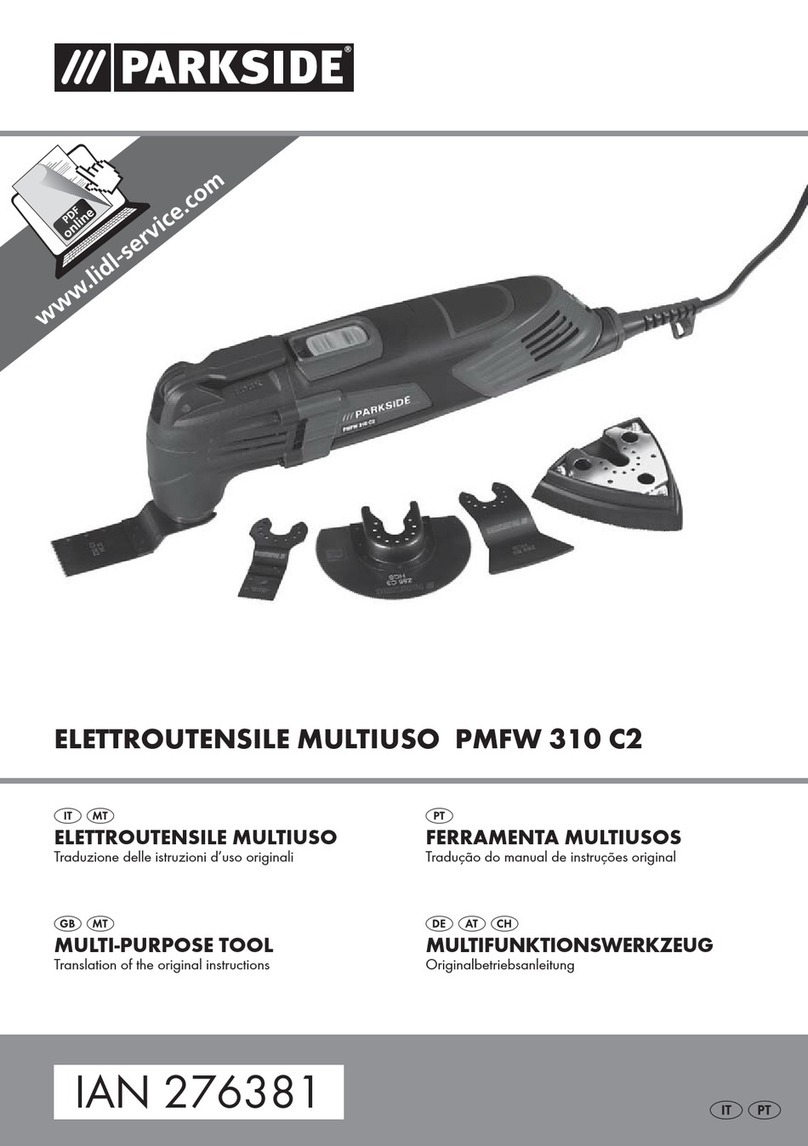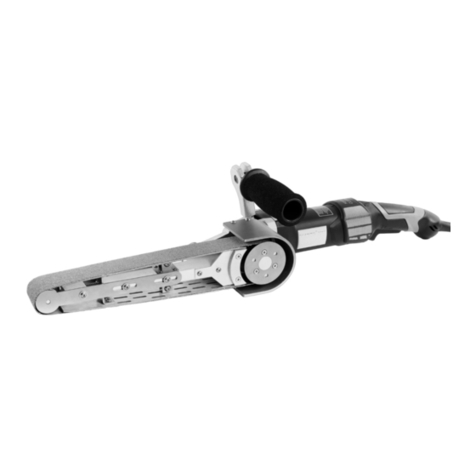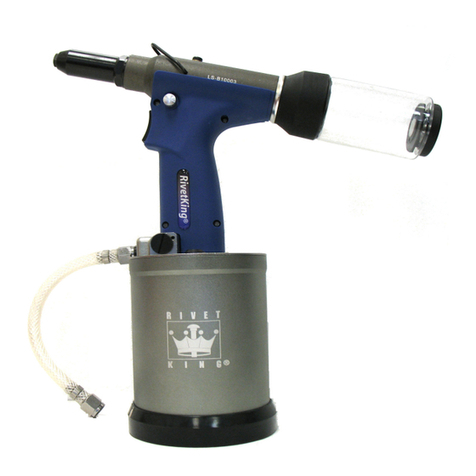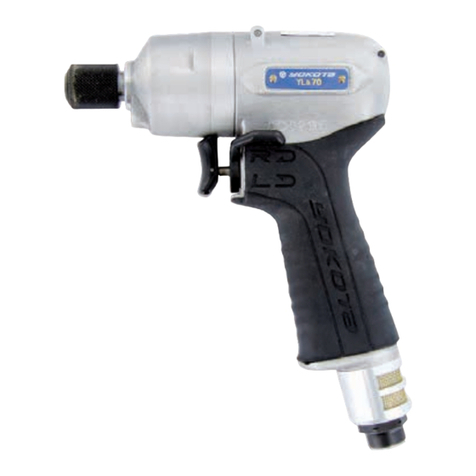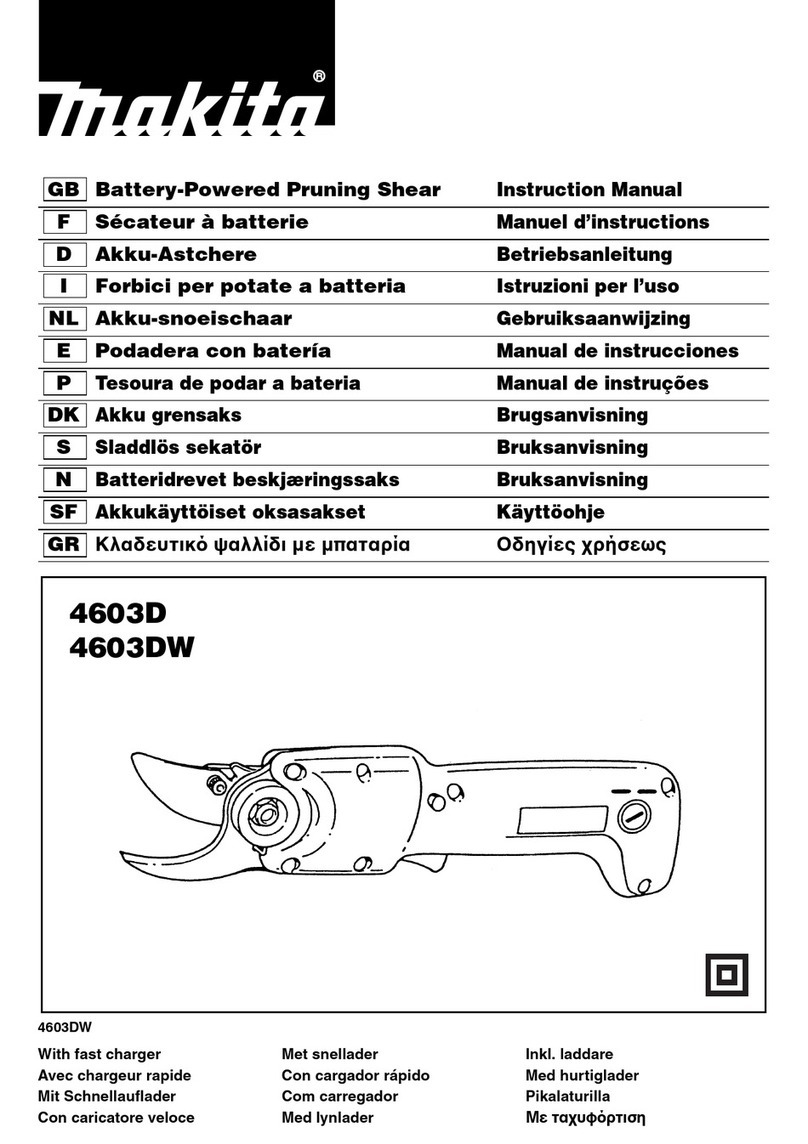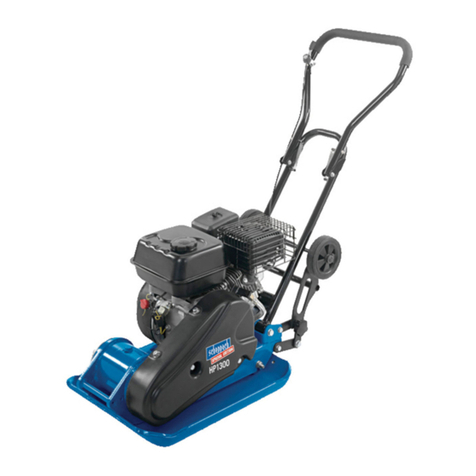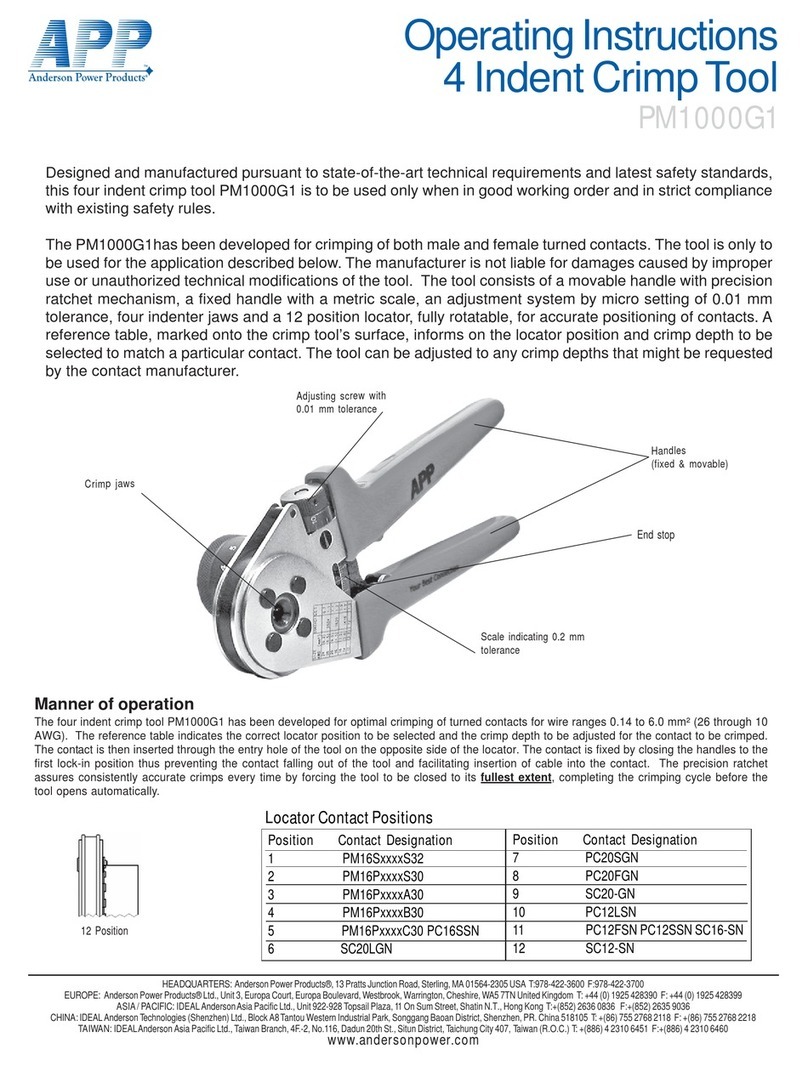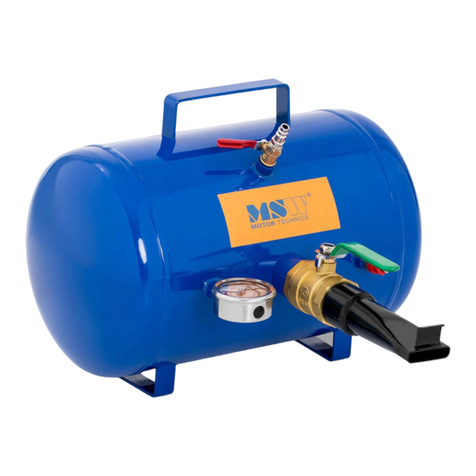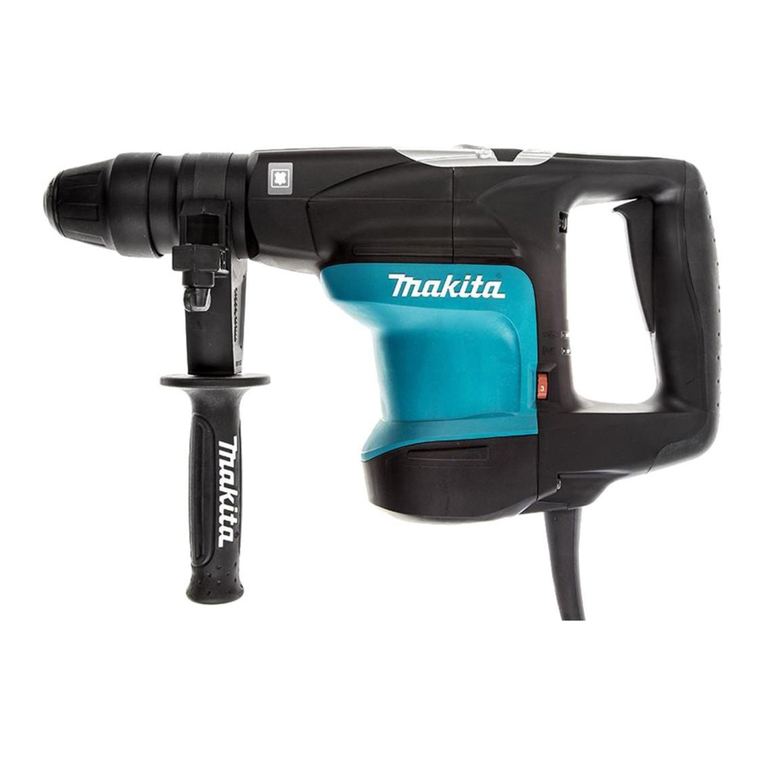Intellijel Cylonix Shapeshifter User manual

1
The SHAPESHIFTER is a dual digital voltage controlled wavetable-based oscillator in a 26-HP Eurorack format.
The wavetables consists of 128 banks, each with 8 individual 512-sample waveforms, for a total of 1024 waves. The
choice of waveform within the currently selected bank is under voltage control. There is smooth interpolaon between
the waveforms within a bank, allowing a very wide range of dierent possible waveshapes. Oscillator 1 can be oper-
ated in a CHORD mode, which runs 8 copies of the oscillator in parallel with adjustable detuning, leading to very fat, rich
waveforms. The oscillators have extensive modulaon capabilies including audio rate (98KHz) Frequency and Phase
Modulaon (FM and PM) via external sources. Nonlinear combinaon processes allow the outputs of the two oscillators
to interact to generate complex mbres and sonic textures. The SHAPESHIFTER module also includes the analog wave
folder circuitry from the intellijel mFold II module to add analog warmth and metallic rasps to the digital output.
The module includes a sophiscated preset mode where panel sengs can be stored. There are 12 user-prgrammable
preset slots and another 52 volale slots that can be used as a scratchpad. These scratchpad slots are inialized to inter-
esng presets on module powerup. The capabilies of the preset mode is not limited to mere passive storage of sengs,
however. In this mode the user can also step through, or sequence, the sengs, either in order or randomly in response
to pulses input to the external sync input. This gives the user the ability to generate complex sequences of sounds. The
preset mode also allows the user to morph between the current panel sengs and a preset providing a very powerful
real-me performance tool.
But, there is one more thing ... the SHAPESHIFTER also includes a 64-band vocoder!
15
Active Scale
SHAPESHIFTER Manual v 1.04
1
2
3
4
5
7
6
8
9
10
12
Active Scale
14
15
16
17
18
23
24
25
11
19
20
22
21
26
13
27
28

2
Front Panel Elements (numbers refer to the diagram on the rst page)
MANUAL DATA INPUT - this is a rotary encoder which is used to enter data in various operaon modes.
Pushing on the encoder acvates a switch which enters and exits the PRESET mode. The red LED above
the encoder indicates whether or not the PRESET mode is acve. When the LED is lit the PRESET mode is
acve.
WAVE BANK/SAVE BUTTON - this buon, when pressed, switches the rotary encoder to entry of the
acve wave bank for oscillator 1 or 2. Successive presses of the buons toggles between oscillator 1 and
oscillator 2. When bank select is acve, the top line of the LCD display will show a descripve tle for
the currently selected bank. The waves corresponding to each wave bank are depcited in Appendix A.
When the module is in PRESET mode (indicated by the illuminaon of the red LED above the rotary en-
coder) this buon has a dierent funcon - that of saving the current front panel control state into the
currently selected preset.
SYNC/PULSE/STEP BUTTON - this buon, when pressed, switches the rotary encoder to selecon of the
SYNC mode. A second press of the buon switches the rotary encoder to selecon of the PULSE output
source.
When the module is in PRESET mode (indicated by the illuminaon of the red LED above the rotary en-
coder) this buon has a dierent funcon - that of entering the PRESET STEP mode.
MODA/MORPH BUTTON - this buon, when pressed, switches the rotary encoder to selecon of the
MODA desnaon.
When the module is in PRESET mode (indicated by the illuminaon of the red LED above the rotary en-
coder) this buon has a dierent funcon - that of entering the MORPH mode.
CHORD TYPE/MULTI/LOAD BUTTON - this buon, when pressed, switches the rotary encoder to selec-
on of the MULTI seng for oscillator 1. A second press of the buon switches the rotary encoder to
selecon of the MULTI seng for oscillator 1. If CHORD mode is acve (as indicated by the illuminaon
of the LED above the CHORD mode buon) then a third buon press will switch the rotary encoder to
selecon of the CHORD type.
When the module is in PRESET mode (indicated by the illuminaon of the red LED above the rotary
encoder) this buon has a dierent funcon - that of loading the control sengs from the currently
selected PRESET.
INT. FM POTENTIOMETER - this potenometer provides an oset that is summed with the external IFM
input signal to produce the signal that sets the modulaon of oscillator 1’s frequency by the output of
oscillator 2. The internal FM is computed at the system clock rate of 25 MHz, providing very high-quality
aliasing free modulaons.
INT. SYNC BUTTON - this buon toggles the internal sync on and o. When on, as indicated by the il-
luminaon of the LED above the buon, both oscillators 1 and 2 are synchronized at the start of each
cycle of an internal synchronizaon oscillator running at the same frequency as oscillator 1 (except that
the synchronizaon oscillator is not aected by the FM inputs to oscillator 1). The specic response of
the oscillators to the synchronizaon pulses depends on the SYNC mode seng.
1
2
3
4
5
7
6

3
8
9
10
12
11
13
Front Panel Elements (connued...)
RATIO/TIME POTENTIOMETER - this potenometer provides an oset to the oscillator 2 RATIO seng.
This is summed with the external RATIO input signal. The pitch of oscillator 2 is shied by an amount
proporonal to this sum. Oscillator 2’s frequency seng is also used to set the delay me for the echo
eect, thus the RATIO/TIME potenometer can be used to alter the delay me.
QUANT. BUTTON - this buon, when pressed, toggles quanzaon of the oscillator 2 frequency rao on
and o. When rao quanzaon is enabled the pitch of oscillator 2 is ed directly to the pitch of oscilla-
tor 1. The external PITCH2 input is ignored in this situaon. There are 16 dierent quanzed raos avail-
able: [1/8, 3/16, 1/4, 5/16, 3/8, 1/2, 5/8, 3/4, 1, 5/4, 3/2, 2, 3, 4, 6, 8].
MODULATION INPUT ATTENUATORS - these mini-potenometers (without knobs) serve to adjust the
level of the modulaon inputs (those coming from the second row of jacks from the boom of the front
panel).
FINE and COARSE POTENTIOMETERS - these two potenometers provide an oset to the pitch for both
oscillators. This oset is summed with the external pitch input signals (PITCH1 and PITCH2), as well as
the RATIO signal in the case of oscillator 2, to produce the oscillator pitches.
MODULATION INPUT JACKS - the top row of jacks are used to input eight dierent modulaon signals.
These signals include:
RATIO: adjusts the rao of the frequency of oscillator 2 as compared to that of oscillator 1.
IFM: sets the level of the internal frequency modulaon of oscillator 1 by oscillator 2.
FM 1: audio rate linear frequency modulaon of oscillator 1.
FOLD CV: adjusts the amount of waveform folding imposed by the analog wave folder.
MOD A: audio rate modulaon input with a number of dierent modulaon targets.
SHAPE 1: modulates the shape of oscillator 1’s waveform within the current wavetable bank.
SHAPE 2: modulates the shape of oscillator’ 2s waveform within the current wavetable bank.
MOD B: low rate modulaon input with a number of dierent modulaon targets.
PEAK/LFO 1 LED - this LED indicates whether either of the two audio-rate modulaon inputs, FM 1 and
MOD A, have reached the limits of their range, and hence whether clipping of these signals is occuring.
If you see the PEAK LED come on, turn down the aenuator for these inputs. When oscillator 1 is op-
erang in LFO mode, this LED no longer signals the presence of peaks, but instead indicates the sign of
output 1 (i.e. the LED is illuminated whenever output 1 is posive).
INPUT JACKS - the four lemost jacks in the boom row are used to input the following signals:
PITCH 1: this input sets the pitch of oscillator 1. It has a 1 volt/octave scale factor.
PITCH 2: this input sets the pitch of oscillator 2. It has a 1 volt/octave scale factor. This jack is
normalized to the PITCH 1 jack, which means that if no cable is plugged into the PITCH 2 jack, the PITCH
2 input follows the signal input to the PITCH 1 jack.
SYNC: posive-going pulses input to this jack cause the oscillators to be synchronized, according
to the current SYNC mode sengs. These pulses are also used to trigger the percussive aacks when
the module is in PERC mode, and cause stepping of the presets when preset stepping is acvated.
FOLD IN: the signal input to this jack is fed to the input of the analog wavefolder circuitry. It is
normalized to the OUT 1 jack, so that if no cable is plugged into the FOLD IN jack, the input to the wave-
folder is taken from output 1.
14

4
Front Panel Elements (connued...)
TWO-LINE LCD DISPLAY - the top row of this display is used, in various modes, to show the waveform
banks for the two oscillators, the sync mode, the pulse output source, the MODA desnaon, the MULTI
sengs, and the chord type. When PRESET mode is acve the top row of the display shows the preset
number, the preset step mode parameters, and the morph preset. The boom row of the display is used
to show the various MODB parameter sengs: the combinaon mode, oscillator 1 waveform lt, echo
level, chord mode detuning, chord mode overdrive level, and the percussion mode decay me.
MOD B/MORPH POTENTIOMETER - this potenometer provides an oset for the MOD B modulaon
level. This is summed with the external MOD B input to provide the overall MOD B modulaon level.
The potenometer gives a zero value when at the 12 o’clock seng, and negave osets when rotated
counter-clockwise and posive osets when clockwise. When a parameter (such as the TILT level) is se-
lected to be a MOD B desnaon, the lower row of the display will show the current value of the modu-
laon level. When the MORPH mode is enabled while in PRESET mode, the MOD B/MORPH control will
set the level of morphing from the panel control sengs to the currently selected preset values. Full
counter-clockwise gives the panel sengs while full clockwise gives the preset sengs.
COMBO MODE BUTTON - this buon, when pressed, switches the rotary encoder to selecon of the
nonlinear outputs combinaon modes. The encoder selected mode is displayed on the boom row of
the LCD display. Subsequent presses of the buon toggles the MOD B modulaon on and o. When the
MOD B modulaon is enabled the LCD display will change to show the oset to the selected mode.
TILT/DRIVE BUTTON - this buon, when pressed, switches the rotary encoder to seng of the wave-
form TILT level for oscillator 1. The TILT parameter seng is displayed on the boom row of the LCD
display. Subsequent presses of the buon toggles the MOD B modulaon on and o. When the MOD B
modulaon is enabled the LCD display will change to show the oset to the TILT seng. When CHORD
mode is acve, the output 1 DRIVE level will be set and displayed instead of the TILT level.
DELAY BUTTON - this buon, when pressed, switches the rotary encoder to seng of the ECHO level.
The seng is displayed on the boom row of the LCD display. Subsequent presses of the buon toggles
the MOD B modulaon on and o. When the MOD B modulaon is enabled the LCD display will change
to show the oset to the echo level.
DETUNE/DECAY BUTTON - this buon, when pressed, switches the rotary encoder to seng of the
detuning for oscillator 1 in CHORD mode. The DETUNE parameter is displayed on the boom row of
the LCD display. Subsequent presses of the buon toggles the MOD B modulaon on and o. When the
MOD B modulaon is enabled the LCD display will change to show the oset to the DETUNE parameter.
When PERC mode is acve, the percussive envelope DECAY me will be set and displayed instead of the
DETUNE parameter value.
SHAPE 2 POTENTIOMETER - this potenometer selects the waveform for oscillator 2 from the 8 wave-
forms in the currently selected wave bank. There is a smooth interpolaon between the waveforms.
This seng is summed with the external SHAPE 2 modulaon input to provide the actual selecon.
15
16
21
20
18
19
17

5
26
25
27
Front Panel Elements (connued...)
CHORD MODE BUTTON - this buon, when pressed, toggles the CHORD mode on and o. When CHORD
mode is acve, 8 detuned copies of oscillator 1 are running. These copies are shied in relave pitch in
musical intervals to produce chords. There are 64 dierent chords that are available. When the CHORD
mode is turned on, the upper row of the display will indicated the currently selected chord type. This
selecon can be changed with the rotary encoder.
FOLD POTENTIOMETER - this potenometer sets the amount of folding imposed by the waveform
folder. As this control is part of the analog waveform folder circuitry its seng is not shown on the LCD
display.
PERC MODE BUTTON - this buon, when pressed, toggles the PERCUSSION mode on and o. When this
mode is acve output 1 is passed through a digital amplier whose gain is controlled by a simple enve-
lope. The envelope has a very sharp aack and an exponenal decay. The decay rate is determined by
the DECAY parameter seng. The envelope is triggered by posive-going pulses received at the external
sync input jack.
SHAPE 1 POTENTIOMETERS - this potenometer selects the waveform for oscillator 1 from the 8 wave-
forms in the currently selected wave bank. There is a smooth interpolaon between the waveforms.
This seng is summed with the external SHAPE 2 modulaon input to provide the actual selecon.
LFO MODE BUTTON and LFO 1,2 LEDs - this buon, when pressed, cycles through the enabling of LFO
mode for oscillators 1 and 2. The rst buon press turns on LFO mode for oscillator 2 only. The second
buon press turns on LFO mode for oscillator 1 only, the third buon press enables LFO mode for both
oscillators, and the fourth buon presses turns o LFO mode for both oscillators. In LFO mode the pitch
of the oscillator is dropped by 7 octaves (frequency is divided by 128). When LFO mode is enabled for
oscillator 2 and quanzaon is o, the pitch of oscillator 2 is no longer aected by the COARSE and FINE
knobs. It is only aected by the PITCH 2 input and the RATIO control and input in this situaon.
OUTPUT JACKS - the four rightmost jacks in the boom row are used to output the following signals:
OUT1: outputs the oscillator 1 waveform aer passing it through the nonlinear combinaon
process and the echo/delay eect. The signal is internally generated at 25MHz but is downsampled to
98KHz before passing through a DIgital to Analog converter.
OUT 2: outputs the oscillator 2 waveform. The signal is internally generated at 25MHz but is
downsampled to 98KHz before passing through a DIgital to Analog converter.
PULSE: outputs a two-level signal (0-5V) derived from the oscillator 1 or oscillator 2 waveforms
(the specic output depends on the parcular PULSE mode selected).
FOLD: this is the output of the analog wavefolder.
PULSE/LFO 2 LED - this LED indicates whether the PULSE output is high (5 volts) or low (0 volts). When
oscillator 2 is operang in LFO mode, this LED no longer displays the PULSE output value, but instead
indicates the sign of output 2 (i.e. the LED is illuminated whenever output 2 is posive).
28
23
22
24

6
SIMPLIFIED SIGNAL FLOW DIAGRAM
oscillator 2
phase accumulator
oscillator 1
phase accumulators
(x 8)
oscillator 2
wave table
oscillator 1
wave tables
(x 8)
nonlinear
waveform
combiner
envelope generator
and amplier
25MHz to 98KHz
sample rate reducon
64-band
Vocoder
Comb Resonator/
Delay Line
IFM
PITCH2
PITCH1, RATIO
MOD A
TILT
PITCH1
CARRIER
MODULATOR
output1 output2
WAVE FOLDER FOLD
FM1
PULSE
SHAPE1 SHAPE2

7
Nonlinear Waveform Combinaon Modes
The outputs of the two oscillators are sent through a nonlinear combinaon process before going to the echo/
delay eect and then onto output 1. The combinaon process allows the generaon of complex mbres and
interacons between the two oscillators, as shown in the gures on the next two pages.
Press the COMBO MODE buon to acvate the rotary encoder for selecon of the combinaon mode. The
selected combinaon mode will be shown in the boom row of the LCD display. The COMBO MODE parameter
can also be modulated by the MOD B input, which is acvated with a second press of the COMBO MODE but-
ton. When MOD B modulaon is acve the lower row of the LCD display will change to show both the nominal
seng and the oset provided by the MOD B modulaon.
There are 8 dierent combinaon modes that can be selected:
cmb:osc1 - in this mode there is no nonlinear combinaon. The output of oscillator 1 is taken as is.
cmb:ring - in this mode the outputs of oscillator 1 and oscillator 2 are mulplied, equivalent to the well-
known ring modulaon eect.
cmb: min - in this mode either the output of oscillator 1 or the output of oscillator 2 is chosen, depending
on which one has the lower value.
cmb:pong - in this mode the output of oscillator 1 is chosen if it has a posive value, otherwise the output
of oscillator 2 is chosen if it has a negave value. If neither of these condions holds, then the output is
set to 0.
cmb:inlv - in this mode the digital bits represenng the two oscillator waveforms are interleaved to
provide the output of the combinaon process. The most signicant bit of oscillator 1 is used as the most
signicant bit of the output, the 2nd most signicant bit of oscillator 2 is used as the 2nd most signicant
bit of the output, and so forth, alternang between taking bits from oscillator 1 and 2.
cmb: and - in this mode the digital bits represenng the two oscillator waveforms are combined using the
logical AND operaon (the AND operaon produces a 1 bit when both the input bits are 1, otherwise it
produces a 0 result).
cmb: xor - in this mode the digital bits represenng the two oscillator waveforms are combined using the
logical XOR operaon (the XOR operaon produces a 0 bit when the input bits have the same value, oth-
erwise when the bits have dierent values it produces a 1 result).
cmb:gLcH - in this mode each bit of the output of the combinaon process is set to 1 whenever the re-
specve bits of oscillator 1 and 2 both become 1, and is set to 0 whenever the respecve bits of oscillator
1 and 2 both become 0. Otherwise the bits hold their value constant. Whenever the 2nd most signicant
bit of the combinaon goes from 0 to 1, the phase of oscillator 1 is ‘bumped’, or oset, by a step of 1/4
cycle (or 90 degrees of phase) and the phase of oscillator 2 is bumped by a step of 1/8 cycle (or 45 de-
grees of phase). The overall eect of this rather complicated combinaon is to provide a noisy and glitchy
sound.

8
RING
MIN
PONG
INLV

9
AND
XOR
gLcH
Examples of the output of the nonlinear waveform combinaon process in the dierent waveform
combinaon modes (the osc1 mode is not shown). The oscillator 1 and oscillator 2 waveforms are
both sine waves, with the frequency of oscillator 2 set to about 16 mes that of oscillator 1.

10
Oscillator SYNC Modes
The oscillators can be reset, or synchronized, whenever a synchronizaon event occurs. A synchronizaon
event happens whenever the voltage at the SYNC input jack rises above about 0.2 volts, and also whenever the
phase of the internal synchronizaon oscillator passes zero when the INT. SYNC mode is enabled. The synchro-
nizaon oscillator runs at the same nominal frequency as oscillator 1 (except that it is not aected by frequen-
cy modulaon or detuning). The specic behaviour of the oscillators in response to a synchronizaon event
depends on the currently selected SYNC mode, as described below and shown in the gure on the next pages.
Press the SYNC/PULSE/STEP buon to acvate the rotary encoder for selecon of the SYNC mode. The selected
SYNC mode will be shown in the upper row of the LCD display.
There are 8 dierent SYNC modes that can be selected:
HardSync - in this mode the phases of both oscillators 1 and 2 are reset to zero when a synchronizaon
event occurs. This is most common type of synchronizaon eect found in other oscillator modules.
SoSync - in this mode the phases of both oscillators 1 and 2 are reset to zero when a synchronizaon
event occurs but only when the oscillator waveform is in the rst quarter of its cycle (i.e. where the phase
is between 0 and 90 degrees). Thus the oscillators might not be reset on every synchronizaon event. This
gives a somewhat noisier and more errac sound than hardsync.
Rev Sync - in this mode the direcon of the waveform is reversed when a synchronizaon event occurs.
For example, a rising sawtooth waveform will become a falling sawtooth waveform. This tends to provide
a rather smooth sound, useful for basses, especially when INT SYNC is enabled.
Hold/1sh - in this mode the output of oscillator 1 switches between being held constant (freeze eect)
or running free on each synchronizaon event. This is useful to provide choppy gang eects with low
frequency SYNC inputs. Oscillator 2 will go through one complete cycle on each synchronizaon event.
BumpSync - in this mode the phase of oscillator 1 is ‘bumped’, or oset, by 1/4th of a cycle (90 degrees)
and the phase of oscillator 2 is bumped by 1/8th of a cycle (45 degrees) whenever a synchronizaon event
occurs.
2=1 Sync - this mode operates in the same way as HardSync mode, except that whenever the output of
oscillator 1 is equal to the output of oscillator 2 an addional synchronizaon event is created that is sent
to oscillator 2 only. The typical result is to create ‘chirps’ in oscillator 2 where its waveform chases that of
oscillator 1, being repeatedly reset with shorter and shorter me intervals unl it catches up.
1=2 Sync - this mode is similar to 2=1 Synch mode except that the addional synchronizaon event is sent
to oscillator 1 only. In this mode the ‘chirps’ are created in oscillator 1.
Sync O - in this mode the synchronizaon events have no eect on the oscillators. It can be useful when
the SYNC input is used to step the presets in PRESET STEP mode to avoid the transient that might other-
wise occur, and also in CHORD mode to prevent the phase alignment of the 8 oscillators (unless you want
that eect!).
Examples of the response of oscillator 2 to synchronizaon events in each sync mode is shown in the next two
pages. The yellow arrows indicate the me of occurence of synchronizaon events.

11
Sync O
Hard Sync
So Sync
Reverse Sync

12
Hold/1sh
Bump Sync
2=1 Sync
Examples of the oscillator 2 output in the dierent sync modes, with int. sync turned on. Oscillator 2
is set to sine wave. In the 1=2 Sync mode (not shown) the output of oscillator 2 would look the same
as in the Hard Sync mode, but the output of oscillator 1 in this case would look similar to the output
shown for oscillator 2 in the 2=1 Sync mode. The yellow arrows indicate the occurence of synchroni-
zaon events (which can come from either the external SYNC input or from the internal sync).

13
PULSE Source Modes
The lower row of jacks on the front panel includes a PULSE output. This output is a two-level signal, either at 0
volts or 5 volts. This signal is derived from the outputs of oscillators 1 and 2 in various ways.
Press the SYNC/PULSE/STEP buon two mes to acvate the rotary encoder for selecon of the PULSE source.
The selected PULSE source will be shown in the upper row of the LCD display.
There are 8 dierent PULSE source modes that can be selected:
+o1 : in this mode the PULSE output is high (5 volts) when oscillator 1’s output is posive. Otherwise it is
low (0 volts).
EOC : in this mode the PULSE output goes high when the output 1 envelope is high. During normal opera-
on this will always be high. During PERC mode, this output will be low during the decay phase of the
percussive envelope and will go high at the end of the envelope cycle. This could be used to trigger other
events in a modular system.
+o2 : in this mode the PULSE output is high (5 volts) when oscillator 2’s output is posive. Otherwise it is
low (0 volts). This mode can be useful as a trigger or gate when oscillator 2 is running in LFO mode.
-o2 : in this mode the PULSE output is high (5 volts) when oscillator 2’s output is negave. Otherwise it is
low (0 volts).
OR : in this mode the PULSE output is high when either oscillator 1’s output is posive or oscillator 2’s
output is posive.
AND : in this mode the PULSE output is high when both oscillator 1’s output is posive and oscillator 2’s
output is posive.
XOR : in this mode the PULSE output is low when oscillator 1’s and oscillator 2’s outputs are both posive
or both negave. Otherwise the output is high.
gLcH : in this mode the PULSE output is equal to the sign of the output of the nonlinear waveform combi-
naon process as when running in gLcH mode. This mode is available even when the combinaon mode is
set to something other than gLcH. This mode can be useful in generang noisy and glitchy triggers.

14
MOD A Desnaons
The MOD A input located in the top row of jacks is converted to digital form at a high sampling rate (98 KHz).
This digized signal can be inserted into the system at a number of points, providing dierent capabilies for
the module. This input is AC-coupled, meaning that it is not sensive to DC (or very low frequency) values.
Press the MOD A/MORPH buon to acvate the rotary encoder for specifying the desnaon of the MOD A
signal. The selected desnaon will be shown in the upper row of the LCD display.
There are eight dierent desnaons for the MOD A input that can be selected:
Phase2 - in this mode the MOD A signal is used to modulate the PHASE of oscillator 2.
Combo 2 - in this mode the MOD A signal is fed into the nonlinear combinaon process in place of the
oscillator 2 output. This allows an external signal to be combined with oscillator 1’s output (for example,
one could do RING MODULATION or XOR-ing of oscillator 1’s waveform with the audio signal from another
module).
Shape 2 - in this mode the MOD A signal is used to address the wavetable for oscillator 2. In this situaon
the PITCH 2 and RATIO signals have no eect, since the phase accumulator for oscillator 2 is disconnected
from the circuit. Instead, the MOD A signal is driving the wave table addressing. If one feeds in a sawtooth
waveform from another oscillator module, the results would be similar to using the internal oscillator 2,
except that the pitch is now being controlled by the external source. But one can feed in waveforms other
than sawtooths, in which case the eect will be similar to a waveshaper. This could be used for distoron
eects, for example.
Voc MOD - in this mode the MOD A signal is used as the MODULATION signal for the 64-band vocoder.
The output of the nonlinear waveform combiner is used as the vocoder’s CARRIER signal. The vocoder
consists of two banks of 64 narrow bandpass lters that covers the frequency spectrum from roughly
15Hz to 15,000Hz. One lter bank is used to measure the energy in the MODULATION signal in each of the
64 frequency channels, while the other is used to lter the CARRIER signal. The individual energy levels of
each channel for the MODULATION signal are mulplied by the individual channel outputs of the CARRIER
signal lter bank. These 64 products are summed together to produce the single vocoder output signal.
The eect is to map the frequency spectrum of the MODULATOR signal onto that of the CARRIER signal.
This can produce ‘roboc’ vocal sounds when the carrier frequency is held constant or melodic singing
sounds when the CARRIER pitch is varied. For best results, the CARRIER signal should use harmonic-rich
waveforms such as sawtooth or pulse waves.
Phase1 - in this mode the MOD A signal is used to modulate the PHASE of oscillator 1.
Combo 1 - in this mode the MOD A signal is fed into the nonlinear combinaon process in place of the
oscillator 1 output.
Shape 1 - in this mode the MOD A signal is used to address the wavetable for oscillator 1. In CHORD mode
the MOD A signal only aects the root oscillator. The other seven are unaected.
Voc CARR - in this mode the MOD A signal is used as the CARRIER signal for the vocoder.

15
CHORD MODE
When CHORD MODE is acvated, by pressing the CHORD MODE buon, the LED above the buon will light up.
More importantly, when CHORD MODE is acve, oscillator 1 will be split into 8 separate oscillators, each out-
pung the same waveform, but with dierent frequencies. This allows chords to be played when the frequen-
cies are chosen to be at musical intervals, and provides a deep, rich, sound when the frequencies are chosen to
be the same (i.e. a UNISON chord), but with slight variaons in tuning between them.
The amount of detuning between the 8 oscillators can be adjusted by pressing the DETUNE/DECAY buon (as
long as PERC. MODE is not acve). When this is done, the lower line of the LCD display will show the current
detuning value, expressed as a number from 0 to 99. This value can be changed with the rotary encoder. A
larger number means a greater detuning. The detuning is an oset to the oscillator frequencies rather than a
scaling, meaning that the eect for a given detuning is less at higher pitches. So you may want to increase the
detuning amount when playing mainly high notes and lower it when playing mainly low notes. The detuning
parameter can also be modulated by the MOD B input, which is acvated with a second press of the DETUNE/
DECAY buon. When MOD B modulaon is acve the lower row of the LCD display will change to show both
the nominal seng and the oset provided by the MOD B modulaon.
When CHORD MODE is rst acvated, the top line of the LCD display will change to showing the currently
selected chord type. This can be selected using the rotary encoder. There are 64 dierent chord types that can
be chosen. The following table shows the label for each type shown in the LCD display, along with the interval
in semitones assigned to each of the 8 oscillators (0 is the root note). Negave numbers indicate suboctave
intervals (pitches below the root note).
CH:uniso 0 0 0 0 0 0 0 0 (unison)
CH: m2nd 0 0 0 0 1 1 1 1 (minor 2nd interval)
CH: M2nd 0 0 0 0 2 2 2 2 (major 2nd interval)
CH: m3rd 0 0 0 0 3 3 3 3 (minor 3rd interval)
CH: M3rd 0 0 0 0 4 4 4 4 (major 3rd interval)
CH: 4th 0 0 0 0 5 5 5 5 (4th interval)
CH:trito 0 0 0 0 6 6 6 6 (tritone interval)
CH: 5th 0 0 0 0 7 7 7 7 (5th interval)
CH:aug5 0 0 0 0 8 8 8 8 (augmented 5th interval)
CH: 6th 0 0 0 0 9 9 9 9 (6th interval)
CH: m7th 0 0 0 0 10 10 10 10 (minor 7th interval)
CH: M7th 0 0 0 0 11 11 11 11 (major 7th interval)
CH:octav 0 0 0 0 12 12 12 12 (octave interval)
CH:suboc 0 0 0 0 -12 -12 12 12 (suboctave + octave)
CH: 2oct 0 12 24 0 12 24 12 24 (octave + 2octave)
CH: min 0 3 7 0 3 7 0 3 (minor triad)
CH:minI1 12 3 7 12 3 7 12 3 (minor triad 1st inversion)
CH:minI2 12 15 7 12 15 7 12 15 (minor triad 2nd inversion)
CH: maj 0 4 7 0 4 7 0 4 (major triad)
CH:majI1 12 4 7 12 4 7 12 4 (major triad 1st inversion)
CH:majI2 12 16 7 12 16 7 12 16 (major triad 2nd inversion)
CH: sus 0 5 7 0 5 7 5 7 (suspended triad)
CH: aug 0 4 8 0 4 8 0 8 (augmented triad)
CH: dim 0 3 6 0 3 6 0 6 (diminished triad)

16
CHORD MODE (connued...)
CH: maj6 0 4 7 9 0 4 7 9 (major 6th)
CH: maj7 0 4 7 11 0 4 7 11 (major 7th)
CH:7M1st 12 4 7 11 12 4 7 11 (major 7th 1st inversion)
CH:7M2nd 12 16 7 11 12 16 7 11 (major 7th 2nd inversion)
CH:7M3rd 12 16 19 11 12 16 19 11 (major 7th 3rd inversion)
CH: dom 0 4 7 10 0 4 7 10 (dominant 7th)
CH:7D1st 12 4 7 10 12 4 7 10 (dominant 7th 1st inversion)
CH:7D2nd 12 16 7 10 12 16 7 10 (dominant 7th 2nd inversion)
CH:7D3rd 12 16 19 10 12 16 19 10 (dominant 7th 3rd inversion)
CH: min7 0 3 7 10 0 3 7 10 (minor 7th)
CH:7m1st 12 3 7 10 12 3 7 10 (minor 7th 1st inversion)
CH:7m2nd 12 15 7 10 12 15 7 10 (minor 7th 2nd inversion)
CH:7m3rd 12 15 19 10 12 15 19 10 (minor 7th 3rd inversion)
CH:hdim7 0 3 6 10 0 3 6 10 (half diminished 7th)
CH:7h1st 12 3 6 10 12 3 6 10 (half diminished 7th 1st inversion)
CH:7h2nd 12 15 6 10 12 15 6 10 (half diminished 7th 2nd inversion)
CH:7h3rd 12 15 18 10 12 15 18 10 (half diminished 7th 3rd inversion)
CH: dim7 0 3 6 9 0 3 6 9 (diminished 7th)
CH:7d1st 12 3 6 9 12 3 6 9 (diminished 7th 1st inversion)
CH:7d2nd 12 15 6 9 12 15 6 9 (diminished 7th 2nd inversion)
CH:7d3rd 12 15 18 9 12 15 18 9 (diminished 7th 3rd inversion)
CH: 7sus 0 5 7 10 0 5 7 10 (suspended 7th)
CH:7s1st 12 5 7 10 12 5 7 10 (suspended 7th 1st inversion)
CH:7s2nd 12 17 7 10 12 17 7 10 (suspended 7th 2nd inversion)
CH:7s3rd 12 17 19 10 12 17 19 10 (suspended 7th 3rd inversion)
CH:D9th 0 4 7 10 14 14 7 10 (dominant 9th)
CH:9D2nd 12 16 7 10 14 14 7 10 (dominant 9th 2nd inversion)
CH:Dm9th 0 4 7 10 13 13 7 10 (dominant minor 9th)
CH:Dm9-2 12 16 7 10 13 13 7 10 (dominant minor 9th 2nd inversion)
CH: maj9 0 4 7 11 14 14 7 11 (major 9th)
CH:9M2nd 12 16 7 11 14 14 7 11 (major 9th 2nd inversion)
CH: min9 0 3 7 10 14 14 7 10 (minor 9th)
CH:9m2nd 12 15 7 10 14 14 7 10 (minor 9th 2nd inversion)
CH: M6/9 0 4 7 9 14 4 7 9 (major 6/9)
CH: m6/9 0 4 7 9 14 4 7 9 (minor 6/9)
CH: 9b5 0 4 6 10 14 14 6 10 (9th at 5th)
CH: 9#5 0 4 8 10 14 14 8 10 (9th sharp 5th)
CH:D11th 0 0 7 10 14 18 7 18 (dominant 11th)
CH:m11th 0 3 7 10 14 17 14 17 (minor 11th)
CH: wide 0 12 14 17 7 24 -12 7 (octave, 9th, 11th, h, 2octave, suboctave, h)
The tuning of the chords can be switched between Just Intonaon and Equal Temperament. This is
accessed by pressing the Chord Type/Mul/Load buon while Chord Mode is acve. Use the rotary
encoder to switch between the two tuning methods.

17
The MULTI seng modies the way in which the wavetables are read. Normally the wavetables are read in 512
sample chunks, called ‘waves’. These waves are shown in Appendix A. In the MULTI modes successive waves
are strung together to provide more complex waveforms. There are four dierent MULTI modes, corresponding
to 1 wave (normal operaon with 512-sample waveforms), 2 waves strung together (1024-sample waveforms),
4 waves strung together (2048-sample waveforms), and 8 waves strung together (4096-sample waveforms).
To adjust the MULTI sengs for oscillator 1, press the CHORD TYPE/MULTI/LOAD buon. If CHORD mode is o
the LCD display will show “Mul1: N”, where N is the current mul seng for oscillator 1. The seng can then
be adjusted with the rotary encoder to a value of 1, 2, 4, or 8. The number (1,2,4,8) indicates how many waves
are strung together. To change the mul seng for oscillator 2, press the CHORD TYPE/MULTI/LOAD buon
once more. The LCD display will now show “Mul2: N”, where N is the current mul seng for oscillator 1. If
CHORD mode is o pressing the buon again will take you back to seng for oscillator 1, otherwise it will take
you to seng of the CHORD TYPE.
The gure below illustrates how the waves in a bank are strung together to create the waveforms produced by
the four dierent MULTI sengs.
MULTI SETTINGS
BANK N
WAVE # MULTI = 1
MULTI = 2
MULTI = 4
MULTI = 8
1
2
3
4
5
6
7
8
The 8 single cycle
waveforms from bank N
MULTI MODE waveforms with SHAPE set to minimum (to select the rst wave in the bank)

18
The TILT funcon phase modulates oscillator 1 with its own output. This results in a self-feedback loop which
has the eect of ‘lng’ the waveform, as shown in the diagram below. The amount of feedback, and hence
the amount of lng, is set by the TILT parameter. At large values of the TILT parameter the waveform may
start to become distorted, and even chaoc.
To set the nominal value of the TILT parameter, press the TILT/DRIVE buon. The TILT parameter value can then
be adjusted with the rotary encoder and will be shown in the boom row of the LCD display.
The TILT parameter can also be modulated by the MOD B input, which is acvated with a second press of the
TILT/DRIVE buon. When MOD B modulaon is acve the lower row of the LCD display will change to show
both the nominal seng and the oset provided by the MOD B modulaon.
TILT FUNCTION
TILT = 00
TILT = 07
TILT = 12
TILT = 25
SINE FLUTE1 GAP SAW

19
DRIVE FUNCTION
The DRIVE funcon is operaonal only when CHORD MODE is acve. It applies a variable amount of gain
(between 1 and 3) to output1, followed by a cubic saturaon process. The purpose of this funcon is to com-
pensate somewhat for the loss of amplitude experienced due to phase cancellaon of the mulple waveforms
when in CHORD MODE. The saturaon keeps the peak amplitude within limits, and provides a nice so rollo
of the peaks for most waveforms. In some cases the result may sound distorted at high DRIVE levels.
To set the nominal value of the DRIVE parameter, press the TILT/DRIVE buon. If CHORD MODE is acve, the
DRIVE parameter value can then be adjusted with the rotary encoder and will be shown in the boom row of
the LCD display. The DRIVE parameter can also be modulated by the MOD B input, which is acvated with a
second press of the TILT/DRIVE buon. When MOD B modulaon is acve the lower row of the LCD display will
change to show both the nominal seng and the oset provided by the MOD B modulaon.
The output of the nonlinear waveform combiner, aer going through the envelope amplier, is passed through
a simple comb resonator/delay line. For short delay mes this acts as a resonator, and at long delay mes
it provides an echo eect. The DELAY parameter sets the amount of feedback from the output of the delay
line back to its input, and also sets the wet/dry mix of the input and delayed signals. As the DELAY parameter
increases, the resonator depth, or the echo regeneraon increases. At the same me the wet/dry rao in-
creases. This is needed to prevent saturaon or clipping at higher feedback levels, and means that the level of
the input signal gets lower and lower as the DELAY parameter increases. At the maximum DELAY seng the
feedback is 100% and the input is 0% and the delayed signal will be innitely repeated (a hold or freeze eect).
This can be used in performances to provide overdubbing or looping eects. To do this one quickly changes the
DELAY parameter (using the MOD B knob as described in the next paragraph) to 0, plays some material, then
quickly changes the DELAY parameter to 99 to hold and repeat the material just played.
To set the nominal value of the DELAY parameter, press the DELAY buon. The DELAY parameter value can then
be adjusted with the rotary encoder and will be shown in the boom row of the LCD display (on the display it
is labeled as echo rather than delay). The DELAY parameter can also be modulated by the MOD B input, which
is acvated with a second press of the DELAY buon. When MOD B modulaon is acve the lower row of the
LCD display will change to show both the nominal seng and the oset provided by the MOD B modulaon.
The DELAY parameter does not specify the delay me, however. The delay me is set by the period of oscilla-
tor 2. This permits synchronized LFO echo eects when oscillator 2 is in LFO mode, and produces pitch syn-
chronous resonator eects when oscillator 2’s pitch follows that of oscillator 1 (as when QUANT is turned on).
The signal tracking the period of oscillator 2 is passed through a slew-rate limiter (low pass lter or smoother)
before using it to compute the delay me. This causes a pitch shiing when the pitch of oscillator 2 changes.
At long delay mes (oscillator 2 in LFO mode) this produces long gliding pitch shis, while at short delay mes
(resonator eect) this slew produces anging eects.
DELAY FUNCTION

20
PERCUSSION MODE
Percussion Mode is turned on and o by pressing the PERC. MODE buon. When Percussion Mode is acve,
as indicated by the illuminaon of the LED directly above the PERC. MODE buon, the output of the nonlin-
ear wave combiner is passed through an amplier whose gain is modulated by an exponenal envelope. This
envelope is triggered by a posive-going pulse on the SYNC input jack. The aack phase of the envelope is very
fast (less than 1 msec), and there is no sustain phase. The exponenal decay begins immediately with a me
constant that is set by the DECAY TIME parameter. When Percussion Mode is acve, pressing the DETUNE/DE-
CAY buon will allow the DECAY TIME parameter to be set with the rotary encoder and its value will be shown
in the boom row of the LCD display. The DECAY TIME parameter can also be modulated by the MOD B input,
which is acvated with a second press of the DETUNE/DECAY buon. When MOD B modulaon is acve the
lower row of the LCD display will change to show both the nominal seng and the oset provided by the MOD
B modulaon.
The minimum decay me is about 2msec (to half peak amplitude) and the maximum is about 3 seconds. The
mapping of the DECAY TIME parameter to actual decay mes is split into three disnct non-overlapping me
ranges. From 0-24 the decay mes range from about 2msec to 3 msec, 25-49 ranges from about 20-30 msec,
50-99 ranges from about 50 msec to 3 seconds.
When the PERC. MODE buon is pressed a second me, the system will acvate GATE mode. In this mode the
SYNC input acts as a gate for the envelope. When the SYNC input goes high the envelope will jump immedi-
ately to its maximum value, and will remain there as long as the SYNC input is high. When the SYNC input goes
low the envelope will begin to decay at the rate set by the DECAY TIME parameter.
The output in PERC. MODE when the DECAY TIME parameter is set to 30, acng on a 1KHz sine wave.
The me axis shows a period of 100msec.
Table of contents
Popular Power Tools manuals by other brands
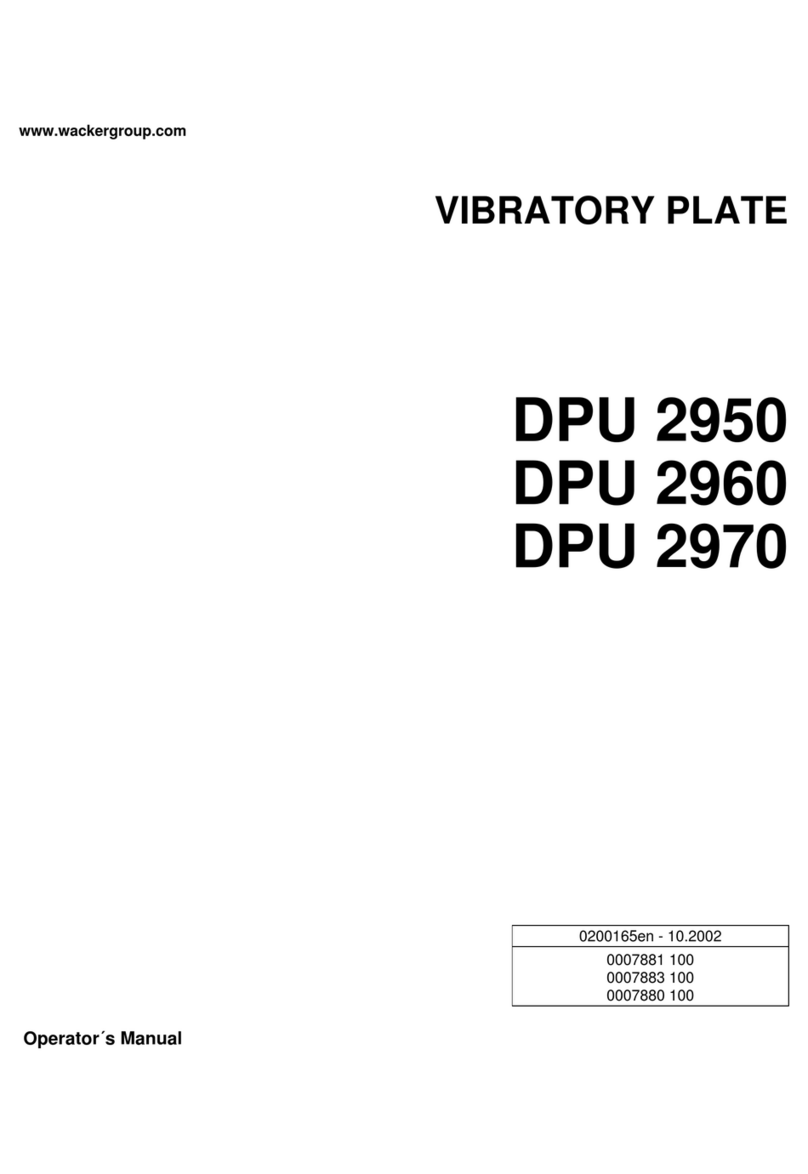
Wacker Neuson
Wacker Neuson DPU 2950 Operator's manual
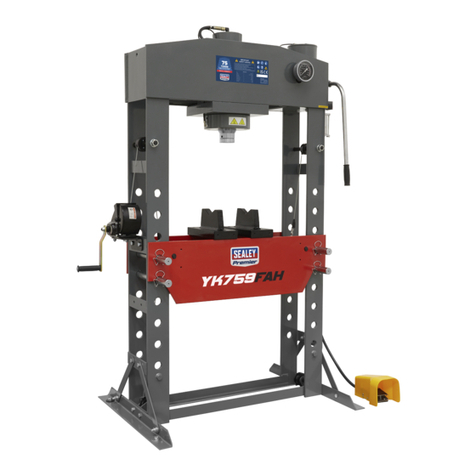
Sealey
Sealey YK759FAH.V2 manual

VEVOR
VEVOR ALK-T1 user manual
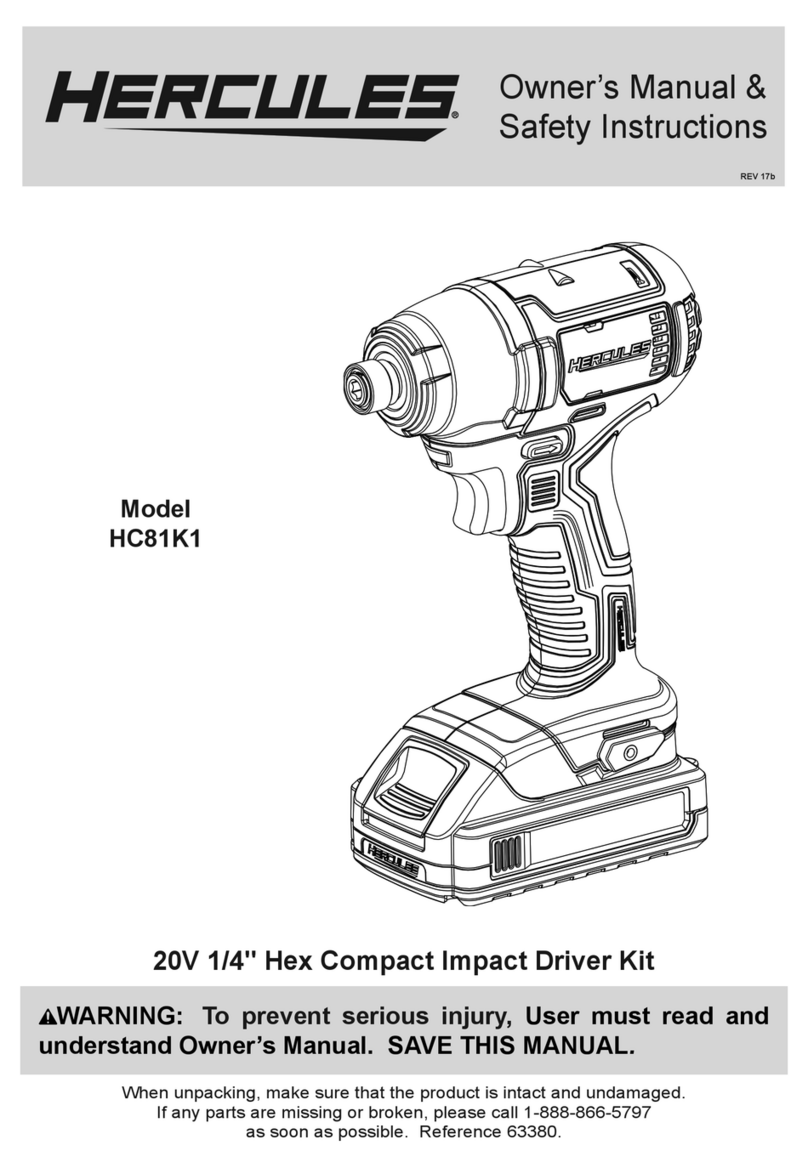
Hercules
Hercules HC81K1 Owner's manual and safety instructions

Dremel
Dremel Dremelite 2610915402 Instruction for attachment and use
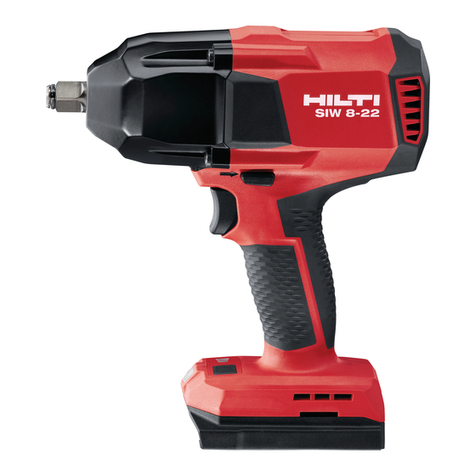
Hilti
Hilti NURON SIW 8-22 Original operating instructions
